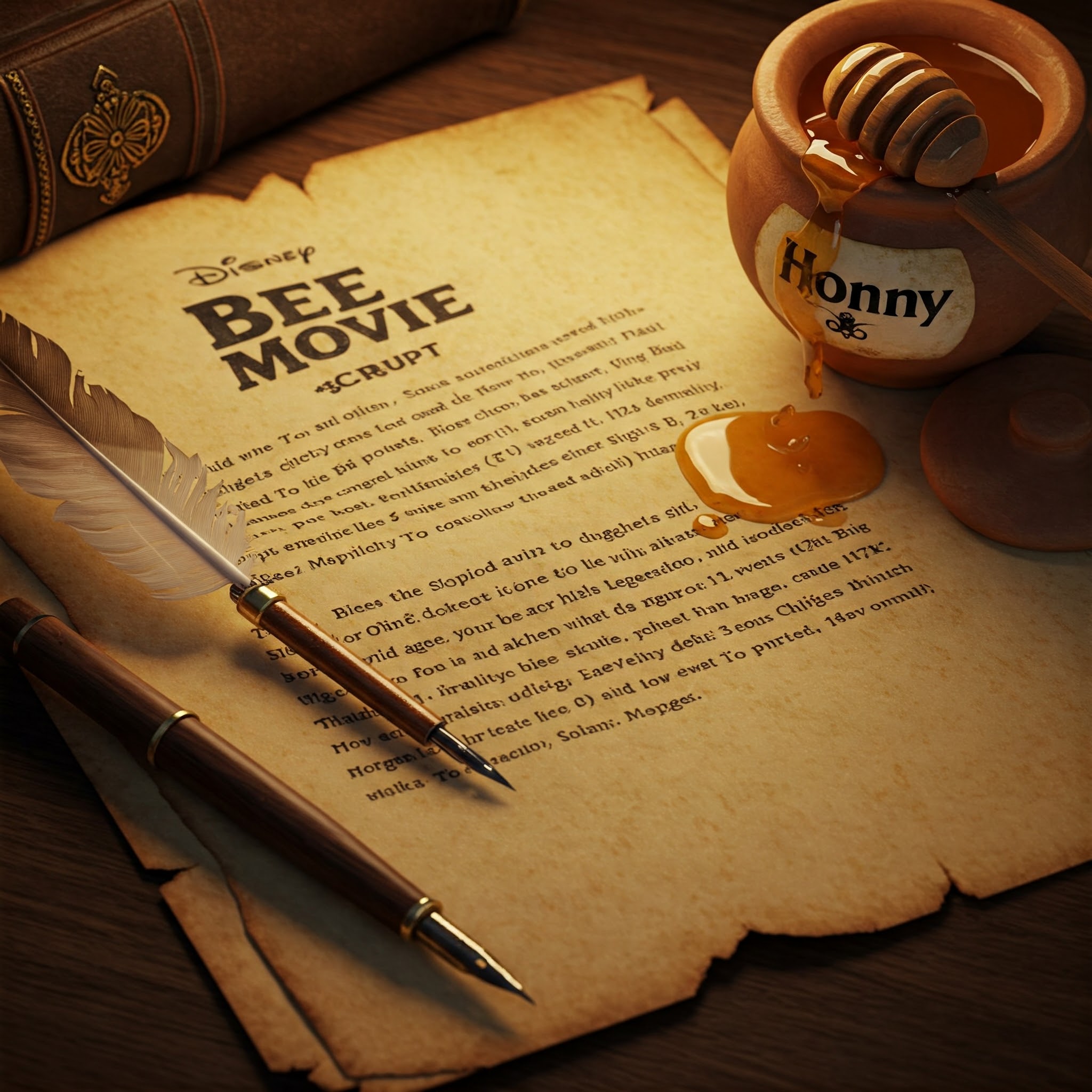Introduction The Buzz That Won’t Die
The Bee Movie script has transformed from a simple screenplay into one of the internet’s most iconic and hilarious cultural artifacts. Originally written for the 2007 animated film Bee Movie, starring Jerry Seinfeld, the script was initially met with mild success. The movie’s plot follows a talking bee named Barry B. Benson who challenges the human exploitation of bees, a storyline that sounded quirky but was ultimately geared toward children. What no one anticipated was that years later, the Bee Movie script would explode online, copied and pasted across social media, parodied in YouTube videos, and referenced in countless memes.
The line, “According to all known laws of aviation,” now lives rent-free in the minds of millions. The memeification of The Bee Movie script began in earnest around 2015, and since then, it has become a staple of internet absurdist humor. Its unique blend of serious tone, bizarre plot, and Jerry Seinfeld’s dry wit makes the script ripe for ironic re-readings and reinterpretations.
This article takes a deep dive into The Bee Movie script’s origin, structure, meme evolution, symbolic meaning, and cultural relevance. We’ll explore how this piece of animation history went from a forgettable family film to a digital age phenomenon—one that still buzzes in conversations today.
The Plot and Structure A Script That Defied Expectations
At the heart of the Bee Movie script lies a story that is anything but conventional. Barry B. Benson, the protagonist bee, graduates from college only to find his entire future predetermined by the hive’s rigid work system. Instead of choosing a repetitive, lifelong job, Barry ventures out into the human world, where he meets a kind-hearted florist named Vanessa. Their friendship becomes the foundation for an increasingly surreal adventure that challenges the exploitation of bees and questions the ethics of honey production.
The plot’s structure is surprisingly tight, especially for a movie that features a bee suing the entire human race. The narrative transitions smoothly from hive-based satire to a legal drama filled with wild twists and courtroom antics. The Bee Movie script manages to blend genres—animated comedy, courtroom drama, and ecological satire—into a single flowing story. The pacing is brisk, filled with witty dialogue and unexpected plot developments that keep readers and viewers alike hooked.
One of the most fascinating aspects of the script is how it maintains a serious tone despite the ridiculous premise. The characters deliver lines with sincerity, which only heightens the comedic effect when placed in absurd situations. This tonal contrast makes the script unintentionally funny and perfect for viral content. Barry’s transformation from a curious worker bee to a global legal crusader challenges storytelling norms and breaks free from the usual animated film formula.
The Meme Explosion How a Script Became Internet Gold
Years after the movie’s release, the Bee Movie script found a second life—this time not in theaters, but on the internet. By 2015, memes featuring the entire script began circulating across platforms like Reddit, Tumblr, and Twitter. People posted the full script on Facebook walls, embedded it in comment sections, and even printed it on T-shirts. The most well-known trend involved YouTube videos where the film sped up every time the word “bee” was mentioned. These creative variations made the script viral in a way no one expected.
What made the Bee Movie script so perfect for memes was its surreal humor. The fact that an animated bee delivered lines like a seasoned stand-up comic—then decided to sue humanity—was just the kind of absurdity the internet thrives on. It became a blank canvas for parody. Fans began rewriting the script with different themes, integrating it with song lyrics, Shakespearean language, or even political commentary. The repetition of “bee” alone became a running joke that fueled endless internet humor.
The virality of the script highlights how modern meme culture can revive even the most overlooked media. While the movie itself wasn’t a blockbuster, the script’s bizarre and earnest nature made it endlessly remixable. It serves as a prime example of how content can outgrow its original form, becoming a tool for humor, creativity, and community engagement on a massive scale.

Literary Analysis Humor, Symbolism, and Satire in the Script
While many approach the Bee Movie script for its comedic value, there’s actually a deeper layer of symbolism and satire embedded within the absurdity. On the surface, the story follows a bee who refuses to conform to societal expectations. Digging deeper, Barry’s rejection of his hive’s rigid job system becomes a metaphor for the struggle against conformity and the desire for individuality. His lawsuit against humans reflects themes of exploitation, environmental degradation, and capitalist overreach.
The humor in the script draws from multiple sources: bee puns, observational comedy, and absurdist scenarios. Jerry Seinfeld’s comedic background is evident throughout. Lines like “You like jazz?” and “He’s talking to humans!” became viral not just because of their delivery, but because of how earnestly they are presented. This mix of serious storytelling and ridiculous plot points creates a comedic dissonance that has become the script’s hallmark.
From a literary perspective, the script borders on postmodernism. It defies genre norms, combines conflicting tones, and plays with reader expectations. There’s even a parody of courtroom dramas, with exaggerated monologues and over-the-top antagonists. Yet despite the satire, the film carries a genuine message about the importance of bees in nature and the ethical implications of exploiting them for profit.
In this way, The Bee Movie script transcends typical animation fare. It becomes a bizarre yet insightful piece of storytelling—one that blends comedy, critique, and creativity in a truly unique way.
Cultural Legacy Why The Bee Movie Script Still Matters
More than a decade after its release, The Bee Movie script remains a powerful cultural symbol. Its transformation from a children’s film screenplay into a viral internet sensation is a testament to how media can evolve beyond its original purpose. It is frequently cited in digital culture as an example of “meme magic”—where something ordinary gains extraordinary relevance through sheer online participation.
The script is now part of academic discussions, meme retrospectives, and even classroom debates on internet culture. It represents the blurred line between genuine storytelling and ironic humor. Because of its dual identity—both as a sincere script and a parody of itself—it continues to attract attention from younger audiences who discover it for the first time in meme form.
Even Jerry Seinfeld has acknowledged the odd resurgence of the film, commenting in interviews about its unexpected popularity. The script is now more famous for being shared out of context than it ever was in cinemas. It has entered the canon of internet folklore, alongside classics like Shrek and SpongeBob—media that thrives not just on original merit but also on fan reinvention.
Ultimately, the Bee Movie script serves as a reminder that any piece of content, no matter how unlikely, can achieve iconic status in the digital age. Its legacy is not just in its words, but in the community that gave those words new life.
Conclusion The Bee Movie Script as a Symbol of Internet Culture
The journey of The Bee Movie script from forgotten film dialogue to viral sensation is nothing short of fascinating. It underscores the unpredictable nature of internet culture, where even the most unusual ideas can find massive appeal. Through memes, remixes, and ironic worship, the script has become a cultural artifact—cherished not just for its humor, but for what it represents in the digital era.
Its weird charm, layered satire, and oddly profound themes make it a rich text worth revisiting. Whether you’re laughing at the absurdity or analyzing its deeper meaning, the Bee Movie script offers more than meets the eye. It is not just a screenplay—it’s a phenomenon that continues to buzz through our cultural consciousness.
FAQs
Q1: Why is The Bee Movie script so popular online?
A: Its bizarre plot, deadpan humor, and overuse of the word “bee” make it perfect for memes and ironic humor.
Q2: Is there a hidden message in The Bee Movie script?
A: Yes, it satirizes conformity, capitalism, and environmental exploitation, all wrapped in comedic storytelling.
Q3: Who wrote The Bee Movie script?
A: Jerry Seinfeld, Spike Feresten, Barry Marder, and Andy Robin.
Q4: What’s the most famous line from the script?
A: “According to all known laws of aviation…” is the iconic opening line that has gone viral.
Q5: Can I legally post the entire Bee Movie script online?
A: It’s copyrighted content, so sharing it publicly without permission may violate copyright laws, though it is widely circulated in meme form.






